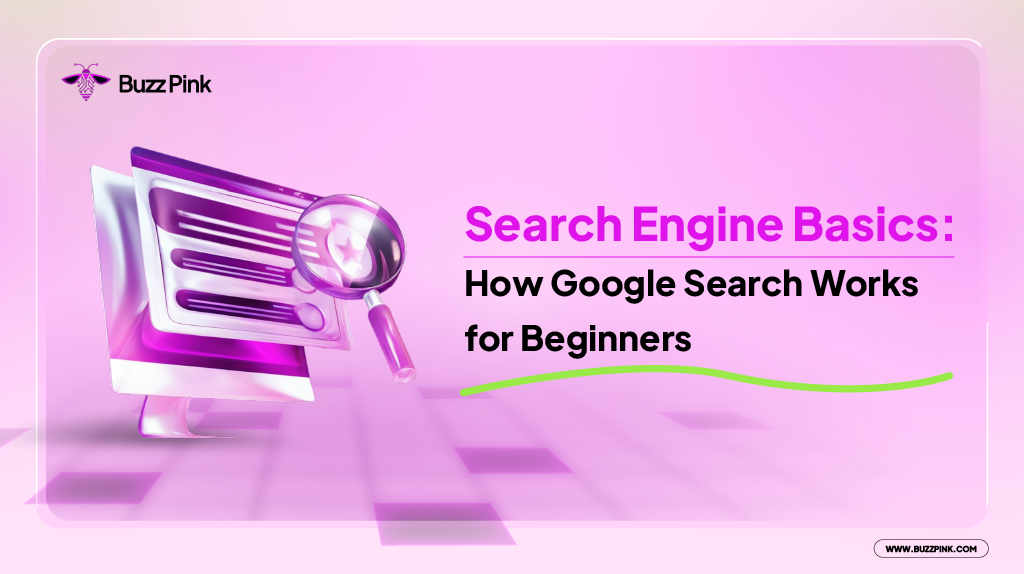If you frequently use Google to look up homework answers, articles, or information about your hobbies, you’re utilizing search engine basics. This search engine allows you to quickly find millions of web pages.
Google Search is one of the world’s largest and most advanced search engines. It’s not as simple as entering a keyword and getting results. Behind the scenes, a lengthy process takes place to ensure that search results are relevant, fast, and useful to you. In this section, we’ll go over how Google Search works step by step.
What Are Search Engine Basics?
 Search engine basics are the fundamentals of how search engines like Google, Bing, and Yahoo function. The index, a type of digital library that stores all of the information from web pages, is the first of two important components of search engines. The second is the algorithm, which is a formula or computer program that decides which pages to show when you search for something.
Search engine basics are the fundamentals of how search engines like Google, Bing, and Yahoo function. The index, a type of digital library that stores all of the information from web pages, is the first of two important components of search engines. The second is the algorithm, which is a formula or computer program that decides which pages to show when you search for something.
Consider this: the index functions similarly to a massive bookshelf. All the books (web pages) are organized there. The algorithm is similar to a knowledgeable librarian who can quickly locate the most relevant book for your search. So, when you type “how to make brownies,” Google searches the index rather than the entire internet from the start.
Search engines exist because people require a quick way to locate information. If the internet is a vast ocean, search engines are maps that provide quick directions. Without search engines, you may have to open each website individually to find information, which can be extremely time consuming.
Aside from assisting people, search engines serve a business purpose. They strive to remain relevant and useful in order to attract more users. The more people use it, the more likely they are to earn advertising revenue. As a result, they must constantly ensure that search results are of high quality and useful.
Why Understanding Search Engine Basics Is Important
Why is it important to understand the fundamentals of search engines? First, you should understand how Google finds web pages. If you have a blog or a website, knowing these fundamentals can help your pages appear higher in search results.
Second, by understanding the fundamentals, you can tell the difference between organic (natural) search results and paid advertisements. This is necessary so that you do not become confused when looking for truly neutral information.
Third, if you understand the fundamentals of search engines, you can learn how to optimize websites. This is essential knowledge for anyone interested in starting an online business or having their writing read by a large number of people. So, you understand not only how to search, but also how to be “searched” by others.
Step-by-Step Guide to Understanding Search Engine Basics
 Before search results appear, Google performs three critical steps: crawling, indexing, and serving. Consider it similar to the food production process. Raw ingredients (web pages) are processed (indexed) before being served on a plate (search results).
Before search results appear, Google performs three critical steps: crawling, indexing, and serving. Consider it similar to the food production process. Raw ingredients (web pages) are processed (indexed) before being served on a plate (search results).
Users cannot see this process. For us, simply type in the Google search bar, and the results will appear immediately. But, behind the scenes, millions of computers and intelligent algorithms collaborate to produce quick, accurate, and relevant outcomes.
Crawling
The first step is to crawl. Crawling is similar to how Google searches the internet for new pages. Google does not have a complete list of all websites in the world, so it must continue to search. This process is known as URL discovery, and it is used to find web addresses.
Google can discover pages in a variety of ways. First, follow the links on other pages. For example, if site A links to an article on site B, Google will be able to access it. Second, from the sitemap.xml file provided by the website owner. This sitemap is similar to a special map provided to Google so that it understands which pages are important. Third, based on a manual request in Google Search Console.
Read More: What Is Long Tail Keyword? The Ultimate Guide How to Use It
After determining the address, Google uses a special program known as Googlebot to “crawl” or check the page. GoogleBot is a type of digital robot that can open pages, read their contents, view images, and even execute JavaScript code to comprehend the page’s content.
However, not all webpages can be crawled. Sometimes, website owners prohibit this in their robots.txt file, and some pages require a login to access. In such cases, Google is unable to access them.
The crawling process also necessitates careful observation. If Googlebot crawls too fast, the website server may crash. That is why Google’s speed varies according to server response. If the server returns an error (such as HTTP 500), Googlebot will slow down.
With this crawling process, Google can “collect” billions of pages per day. After that, the crawled pages proceed to the next stage: indexing.
Indexing
The second stage involves indexing. After “fetching” a page, Google must first understand its content. Indexing involves analyzing text, images, videos, titles, and other important attributes (e.g., <title> tag or alt images).
Google also determines whether the page is unique or duplicated. If there are multiple pages with similar content, Google will select the primary page (known as the canonical) that best reflects it. The remaining pages become alternative versions that can be displayed as needed.
Google also considers other aspects of the page, such as the language used, the target country, and whether the website is user-friendly. All of this data is stored in the Google Index, a massive library that houses millions of terabytes of data from all over the world.
However, not every crawled page is automatically indexed. The page will not be indexed if the content is poor, thin, or violates the meta robots rules. So having a website isn’t enough; the content must be of high quality and compliant.
The indexing process is critical. If your pages are not indexed, people will be unable to find your website in Google searches. It’s like having a nice shop but not being listed on the mall map.
Serving
The final stage is serving, during which Google displays search results to users. When you enter a keyword, Google searches the index rather than the entire internet. From there, Google’s algorithm decides which pages are the most relevant and high-quality.
Page ranking happens automatically. Google does not accept payment to rank pages higher (except for ads that are clearly labeled “Sponsored”). Hundreds of factors contribute to relevance, including keywords, location, language, device (mobile or PC), and even your search history.
For instance, if you enter “nearest bicycle shop.” If you are in Singapore, the results will differ from those in Bukit Panjang. If you type “modern bicycle,” you might get more images rather than a list of shops. As a result, the search results may differ depending on the context.
Sometimes Search Console reports that a page has been indexed, but it does not appear in the results. This could be due to the content being irrelevant or low quality, or because meta rules prevent it from appearing.
So, serving is essentially Google’s attempt to provide the best results for users’ requirements. If it is not relevant, users will be disappointed and may switch to another search engine.
Why Google Ranking Matters
Ranking on Google is important because people typically only look at the first page of results. If your website is located at the bottom, it is unlikely to be clicked on.
A good ranking can drive more traffic to your website. If you own a business, this means more potential customers. If you have a blog, this means more traffic.
That is why many people learn SEO (Search Engine Optimization) to boost their website rankings. Here’s how to optimize your Google search results.
What It Has to Do With Google’s Algorithms
Google uses a variety of algorithms, which are computer formulas that determine rankings. These algorithms are extremely complex, taking hundreds of variables into account. However, Google’s primary goal is to provide users with the most relevant, trustworthy, and useful results possible.
Google’s algorithms are also constantly evolving. They are regularly updated to prevent fraudulent manipulation of search results. So, the most important thing is to keep producing quality content, rather than just tricks.
Backlinks are an algorithmic factor. If a lot of other websites link to your page, it means that your website is important. Other considerations include loading speed, mobile friendliness, and keyword relevance.
While we don’t know all of the factors (because Google never fully reveals its secrets), we can identify general trends based on research and experience. Essentially, this algorithm is the driving force behind Google’s search results.
What Determines Google Ranking
 In general, Google ranking is determined by several factors, including the relevance of content to the page title, backlinks from trusted sources, page loading speed, which must be integrated with UX, and mobile friendliness.
In general, Google ranking is determined by several factors, including the relevance of content to the page title, backlinks from trusted sources, page loading speed, which must be integrated with UX, and mobile friendliness.
Relevancy
Relevance is defined as the degree to which the content of a page matches the searched keyword. If you search for “how to make fried rice,” a page with a fried rice recipe will be far more relevant than a page about rice history. Google also considers user interaction, such as whether people click on a page and find it useful or leave quickly.
That’s why it’s critical to create content that is relevant to your target keywords. People require correct answers, so relevance is an important consideration.
Backlinks
Backlinks are links from other websites that direct visitors to your website. They function similarly to recommendations. If your page is linked to by many other sites, Google considers your website trustworthy.
However, not all backlinks work. It is preferable to have a few backlinks from high-quality sites rather than many backlinks from questionable sites. Thus, quality is more important than quantity.
Loading Page
The speed with which the page loads is also important. If your website is slow to load, visitors may leave before the page is fully loaded. Google considers this a negative experience, and your website’s rankings may suffer as a result.
Page loading, while not the most important factor, is still significant. People prefer fast pages, especially when using a mobile phone with unpredictable internet speeds.
Mobile Friendly
Google prioritizes mobile-friendly websites because many people now access it through their mobile phones. This is referred to as mobile-first indexing.
Visitors may abandon your website if it is not mobile-friendly, or if it appears cluttered on a small screen. That is why Google regards this as an important ranking factor.
Conclusion
Search engine basics are the fundamentals of how search engines like Google work, including crawling, indexing, and serving. Understanding this allows you to better understand why specific pages appear in search results and how to make your website more visible.
Google is constantly updating its algorithm to make search results more relevant and useful. So, the key is to create quality content that is quick to access, mobile-friendly, and has a good reputation through backlinks. This increases your website’s chances of appearing on the first page of Google.
Kamila Putri is a content strategist and digital marketing expert who helps brands craft messages that resonate and drive results. With a strong foundation in SEO, brand voice, and data-driven strategy, she has produced content that performs, whether it's optimized web copy, lead-generating campaigns, or conversion-focused messaging. At Buzz Pink, she applies this expertise to help clients grow through smart, search-focused digital strategies that engage, inform, and convert.


